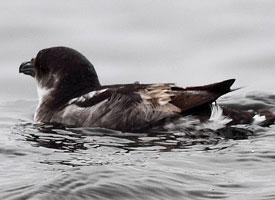
Poids et mesures
| Longueur | de 20 à 26 cm |
|---|---|
| Poids | 200 g |
Statut de conservation
| Menacé |
Description de l'animal
The Peruvian diving petrel, scientifically known as Pelecanoides garnotii, is a small seabird belonging to the family Procellariidae, which includes petrels and shearwaters. This species is endemic to the Humboldt Current off the west coast of South America, primarily found along the coasts of Peru and Chile.Adult Peruvian diving petrels are compact birds, measuring approximately 19 to 21 centimeters in length, with a wingspan of around 38 to 42 centimeters. They weigh between 120 to 200 grams. They have a streamlined body shape that is well adapted to their aquatic lifestyle, with short, stout wings that enable them to "fly" underwater in pursuit of prey. The plumage of these birds is predominantly dark above and white below, which provides excellent camouflage against both aerial and underwater predators; the dark back blends with the ocean depths when viewed from above, and the white belly merges with the sky when seen from below.
The Peruvian diving petrel has a distinctive black cap and a short, black bill. Their eyes are encircled with white feathers, which contrast with the dark feathers on their face. The legs are set far back on the body to aid in swimming, and their webbed feet are black. These adaptations make them agile swimmers but somewhat clumsy on land, where they are vulnerable to predators.
These birds are well adapted to a marine environment and spend most of their lives at sea, only coming ashore to breed. They are nocturnal on their breeding grounds to avoid predators. Their breeding colonies are usually located on offshore islands or in coastal cliffs where they can dig burrows or nest in crevices, safe from terrestrial threats.
The diet of the Peruvian diving petrel consists mainly of small fish and crustaceans, which they catch by diving from the surface and propelling themselves underwater with their wings. They are known to dive to depths of up to 25 meters, although they typically forage in shallower waters.
Breeding occurs once a year, and Peruvian diving petrels are monogamous with strong pair bonds. The female usually lays a single white egg in the burrow, which both parents incubate. After hatching, both parents feed the chick by regurgitating food. The chick grows rapidly, developing a thick layer of down before fledging.
Unfortunately, the Peruvian diving petrel is considered vulnerable to extinction due to a range of threats, including habitat destruction, introduced predators, and environmental changes linked to climate change and oceanographic shifts that affect the availability of their prey. The El Niño Southern Oscillation, in particular, can cause severe disruptions to the Humboldt Current ecosystem, impacting the food supply for these birds.
Conservation efforts are ongoing to protect the Peruvian diving petrel, including the management of breeding sites, predator control, and research into the impacts of fisheries and climate change on their food resources. Their survival is closely tied to the health of the Humboldt Current, which is one of the most productive marine ecosystems in the world.
Nouvelles photos d'animaux
Top 10 des animaux
- Dolphin gull (Leucophaeus scoresbii)
- Diana monkey (Cercopithecus diana)
- Moustached guenon (Cercopithecus cephus)
- Galápagos tortoise (Geochelone nigra complex)
- Russian tortoise (Testudo horsfieldii)
- Japanese macaque (Macaca fuscata)
- Stone loach (Barbatula barbatula)
- Common flying dragon (Draco volans)
- Greek tortoise (Testudo graeca)
- Vendace (Coregonus albula)